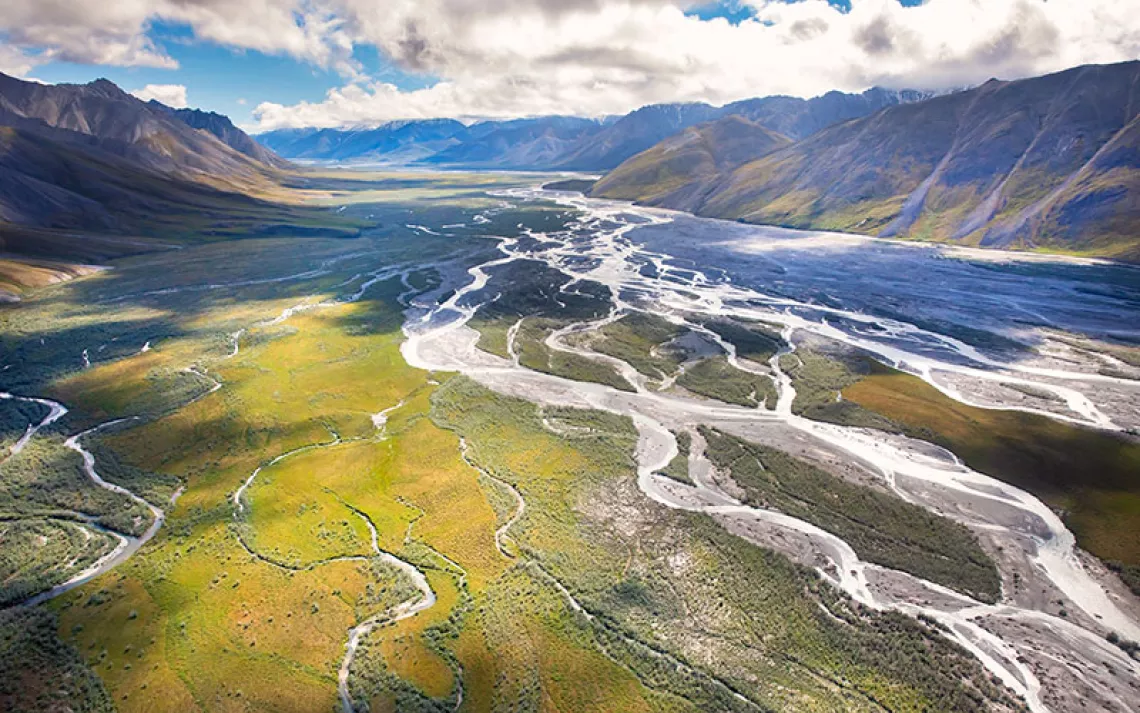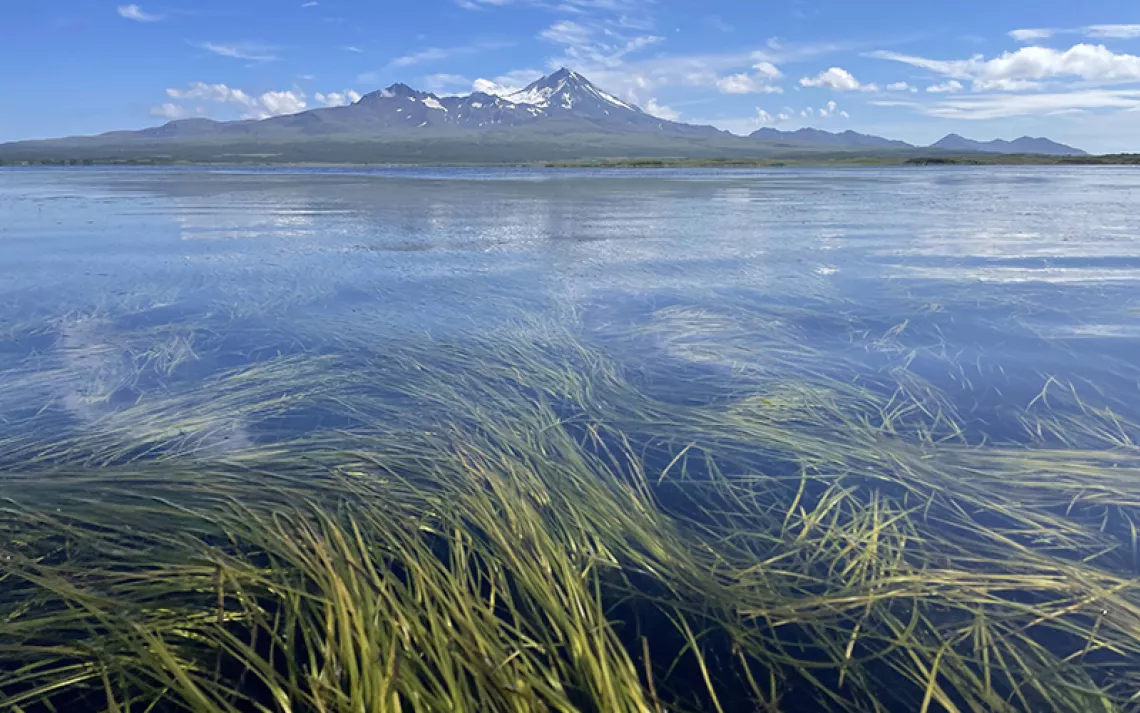Snake Oil for Fossil Fools
We can choose technologies that will keep us warm in the winter, cool in the summer, and get us where we want to go while preserving our natural landscapes

While drilling the Arctic Refuge would make vast amounts of money for certain segments of the oil industry, it would have a negligible effect on California's rolling blackouts, since the state generates less than one percent of its electricity from oil.
Suppose it's midwinter; the heater's cranked up to high, but you're still cold. Would you: Buy a blast furnace? Burn the house down to keep warm? Or get up and close the window?
With heating-oil and gasoline prices the highest they've been since the Gulf War and electricity in some western states up tenfold, the nation's dilemma calls out for a commonsense solution. But the unfortunate conjunction this winter of the California energy crisis with the ascension of Texas oilman George W. Bush opened the door to every bad energy idea squirreled away in the backrooms of oil-funded Washington think tanks. Here's a short list:
- Open up public lands (although not the coastline of brother Jeb's Florida), including the Rocky Mountain Front and Alaska's incomparable Arctic National Wildlife Refuge, to intensive oil development, and pay the oil companies $16 billion to do so.
- Build power plants for the U.S. market across the border in Mexico, where they would be free from U.S. environmental regulations.
- Exempt ancient coal-burning power plants from the Clean Air Act for ten years.
- Reopen the closed book of nuclear energy.
In support of this wish list, a pundit chorus has encouraged consumers to blame the nation's energy woes on environmentalists, holding them responsible for an allegedly short supply of power, continued dependence on foreign oil, and clean-air laws that limit electricity production. "If there are any environmental regulations preventing California from having a 100 percent max output at their plants, as I understand there may be, then we need to relax those regulations," proclaimed President Bush. To get things rolling, Bush set up an energy task force headed by Vice President--and fellow Texas oilman--Dick Cheney, to "act boldly and swiftly" to end America's "reliance on foreign oil." California's experience, he said, is "a warning sign about what could happen if our nation does not have a concerted effort to explore and bring more energy into the country." The implied alternative is to sit alone in the cold and dark.
While drilling the Arctic Refuge would make vast amounts of money for certain segments of the oil industry--especially exploration companies like Halliburton, which Cheney headed until last July--it would have a negligible effect on California's rolling blackouts, since the state generates less than one percent of its electricity from oil. Nor would it provide heating oil to the Northeast, or lower gasoline prices in Chicago. If we decided to drill the Arctic Refuge tomorrow, says the U.S. Geological Survey, the engineering obstacles are so immense that no oil from that remote region could possibly reach the Lower 48 for at least another decade.
Even the libertarian Cato Institute--whom no one has ever accused of over-sentimentality about caribou or arctic foxes--says that drilling the refuge to reduce dependence on foreign oil is nonsense. "You get the impression from W. that America is some sort of latent Saudi Arabia, sitting atop a vast pool of oil that for some inexplicable reason is being left to the bugs and bunnies," writes Jerry Taylor, Cato's director of natural-resource studies. "In reality, however, there simply isn't enough oil in Alaska or other publicly owned lands to significantly expand the world market." The real reason for America's dependence on foreign oil, he writes, is that "it costs between $5 and $7.50 to produce a barrel of domestic oil versus about $1.50 to produce a barrel of Saudi crude. As long as the Persian Gulf nations have a lot of $1.50-a-barrel oil lying around--and they do--they're going to dominate the world market whether we allow drilling in environmentally sensitive areas or not."
Actually, America is sitting atop a vast pool of oil; the only problem is that it's in a place even more fanatically protected than Alaska's caribou grounds or the California coastline. This untapped oilfield is called Detroit, and its lavish contributions to Congress have prevented any improvements in auto fuel economy since the Carter administration. If all those pickups, minvans, and sport-utility vehicles were held to the same standard as cars, we would save a million barrels of oil a day--three times as much as might flow from the Arctic Refuge. And were CAFE (corporate average fuel economy, the average gas mileage of a company's entire fleet of cars and trucks) raised by only 2 miles per gallon, it would save as much oil as we'd get by drilling the Arctic Refuge. And were CAFE raised by a very achievable 40 percent, the United States would save as much oil each year as we import from all the Persian Gulf--with the Arctic Refuge thrown in for good measure. Yet CAFE remains frozen at 27.5 miles per gallon for cars and 20.7 for light trucks. (Because of the glut of gas-guzzling SUVs on the market, Detroit hasn't even been able to meet the light-truck standard since 1997. Instead of improving fuel-efficiency, the automakers got their friends in Congress to waive the law.)

Sign up to receive Sierra News & Views
Get articles like this one sent directly to your inbox weekly.
With this action you affirm you want to receive Sierra Club communications and may vote on policy designated by the Sierra Club Board.
Besides, if we're so desperate for oil from Alaska, why have the oil companies shipped North Slope oil to Asia since 1995? Early this year, Oregon senators Gordon Smith (R) and Ron Wyden (D) called for renewal of a ban on exports of Alaska's crude after the Portland Oregonian revealed that since 1996, BP Amoco has sold Alaskan oil to Asia for less than it could have gotten from U.S. refineries. The strategy, as revealed in a 1995 e-mail exchange between BP managers, was "shorting the West Coast market," creating an artificial shortage to "leverage up" prices. R. Preston McAfee, an economist hired by the Federal Trade Commission, estimated that BP Amoco's move resulted in an increase of one to three cents per gallon of gas at the pump--and motorists in Washington, Oregon, and California pump almost 19 billion gallons a year. Once the higher prices were achieved, the oil companies "voluntarily" declared an end to exports from Alaska.
There's substantial evidence that power providers in California also jacked up prices. As part of that state's deregulation, the utilities were persuaded to sell off most of their plants, which were snapped up by companies like Enron and Reliant (both based in Houston, and both major contributors to President W.). The new energy market gave these companies a strong incentive to restrict supply. "California's energy shortage results not so much from power plants it doesn't have," reported National Public Radio in February, "but from plants it does that aren't operating." Utility watchdogs note that a suspiciously high number of plants were "closed for maintenance" at the height of the power crunch. From August 1999 to August 2000, power-plant shutdowns were up 461 percent; this January, when the state declared the first of 32 consecutive "stage three emergency" power alerts, one-third of California's power plants were shut down. According to the consumer group the Utility Reform Network, this shows that the power brokers are "manipulating and 'gaming' the market in order to ramp up rates to astronomical levels and then keep them there." That charge is now being investigated by California attorney general Bill Lockyer. (This does not seem to be strictly a California phenomenon: A study by the Union of Concerned Scientists found that when deregulation hit New England, power-plant outages jumped 47 percent.)
Trying to spin a situation that might otherwise have consumers up in arms over deregulation and its profiteers, the free-market defenders claim that environmentalists prevented the utilities from adding needed generating capacity to meet an "unforeseen" demand. A typical complaint comes from Onkar Ghate, a fellow at the libertarian Ayn Rand Institute: "Environmentalists have done everything to stop the construction of power plants. . . . The blackouts are an early warning sign of the dangers to human life coming from environmental activism."
In California, however, it's not the Sierra Club or other environmentalists who are blocking new power plants--it's NIMBY neighbors and competing power companies. Modern gas-fired power plants are vastly cleaner than older plants, which is why the Sierra Club is supporting a 600-megawatt natural-gas-fired plant near San Jose. The opposition in this case is coming from high-tech giant Cisco Systems, which doesn't want anything to mar the view from its sprawling new facility (which the Sierra Club does oppose). For its own power needs, Cisco is relying on diesel generators; these produce, watt for watt, more than 50 times as much pollution as the new gas-fired plant would. Nationwide, antiquated power plants account for two-thirds of the nation's sulfur dioxide emissions, one-quarter of all smog-related emissions, and one-fifth of the mercury. Electric utilities spew almost 11 percent of the nation's particulate pollution, which cuts short the lives of 45,000 Americans every year. Because they were "grandfathered" under the Clean Air Act, antique power plants are permitted to emit ten times as much pollution as even modern coal-fired plants. That gives them a competitive edge over cleaner energy sources; from 1992 to 1998, the amount of electricity generated from old coal-fired plants increased by almost 16 percent.
"If you're just looking at fuel cost," says Sierra Club California energy lobbyist Bill Magavern, "old dirty plants look really cheap, because the real cost goes into our lungs." California's antique power plants are gas-fired; some date back to the Truman administration. In the past, they were operated only a few hours a year. Now air-pollution limits are being waived so the dinosaurs can run Southern California's air conditioners this summer.
California's energy needs were hardly unforeseen. Rather, they were accurately predicted by the California Energy Commission in 1992. To help meet the projected demand, the state recommended in 1995--with the Sierra Club's blessing--that the utilities build 1,400 megawatts of new power capacity, about a quarter of it in wind and geothermal. The utilities complained to the Federal Energy Regulatory Commission that the plants were not needed; "existing generation sources," insisted Southern California Edison, "are fully adequate to provide reliable service to consumers until at least 2005." Consequently, the proposed clean, new power plants were laid to rest and forgotten--until now, when their absence is blamed on environmentalists.
The West's power shortages (whether real or contrived) have provided the fossil-fuel lobby with a rallying point for scrapping pollution standards and drilling the Arctic Refuge. Largely missing from the discussion, however, have been the two measures that could actually make an immediate difference: energy efficiency and conservation. "One thing everyone should be able to agree on," says Dan Becker, head of the Sierra Club's global-warming and energy program, "is that we shouldn't use more energy than we actually need."
For example, major home appliances account for about 10 percent of the nation's electricity consumption, but dramatic improvements in their design have the potential for enormous energy savings. Simply bringing all the refrigerators in California up to modern standards would save roughly 1,000 megawatts, enough electricity to power a million homes, or as much as is produced by a large power plant. Replacing the state's inefficient old air conditioners could reduce peak demand by another 1,000 megawatts, and giving away $10 million worth of compact fluorescent lightbulbs could save 120 megawatts. In January, California was burning through that much money in a few hours buying electricity from the Texans on the spot market.
That energy-saving potential, however, is far from being realized. In California, a major reason is that the state's energy-efficiency programs, while publicly funded, are administered by the utilities themselves. Until recently, the body selling the power had no reason to want its use restricted; the unsurprising consequence was that last year Pacific Gas & Electric failed to spend more than $20 million in energy-efficiency money it collected from ratepayers.
For efficiency programs to succeed, consumer research shows that well thought out (and well-funded) education efforts and incentives are essential. A consumer at rest, sadly, is likely to remain at rest. "They will tend to continue past patterns," concludes a study by the Pew Center on Global Climate Change, "not upgrading even when economically attractive and continuing to replace appliances only when they fail." Consumers don't seem to have anything against energy efficiency, as long as the price and quality of the appliance are comparable to the inefficient alternatives. But they prove to be relatively unmotivated by long-term operating savings; when their water heater is leaking all over the basement, they're thinking about how much they're going to be out of pocket at the moment, not the thousands of bucks they'd save over the product's 13-year lifetime if they would only buy a more efficient model. In one survey cited in a study by the Pew Center, 41 percent of consumers wouldn't pay a penny extra for an appliance that saved $50 a year; 24 percent would pay $50 or more, but only 5 percent would pay $200 or more, even if the appliance had a life span far beyond four years.
Overcoming the inherent inertia of the status quo can also be accomplished through the gradual raising of industry standards, as has happened with most major appliances. For example, the energy efficiency of refrigerators has improved so much that if you replace your ten-year-old one with a new model of even average efficiency, you'll have energy savings of nearly 50 percent. Refrigerators have an average lifespan of 19 years; about 5 percent of them fail every year, so progress will be made despite the short-sightedness of the average consumer. (Canny shoppers can, of course, speed up savings--see "Knowledge Is Power.")
The final missing element of the nation's power equation is renewable energy, the one sure shield against volatile fuel prices. As long as the sun continues to shine and the wind to blow, the supply of renewables remains unaffected by foreign-oil cartels or greedy manipulators. Even so, wind, solar, and geothermal are hardly being discussed. "This . . . extremism of saying we should have no oil, no gas, and we're going to do it all by solar and wind--it won't work," declared Senate Majority Leader Trent Lott. President Bush did promise $1.2 billion for renewable energy--with the money to come from bonuses from companies seeking to drill the Artic Refuge.
(Meanwhile, back on the ranch, Bush has had his new ranch house in Texas designed to include renewable features like passive solar heat and a groundwater cooling system, whereby the relative coldness of groundwater is exploited to air-condition a house for one-fifth the cost of a standard compressor system. His dad's home in Kennebunkport, Maine, also features solar panels on its roof.)
Politicians looking to make further contributions could start by giving renewables as big a boost as other energy sources. In California, the alternative-energy programs set in motion by former governor Jerry Brown were largely swept away by the deregulatory tide, which took price as its only criterion. Nationally in the last 50 years, the federal government has subsidized noncarbon energy to the tune of some $150 billion--but 95 percent went to support nuclear power. Today the only action in the nuclear industry is the shuttering of unwanted plants and searching for a permanent repository for its toxic waste, while wind and solar are starting to offer serious competition to fossil fuels. In the West's current overwrought energy market, even solar power, at 15 to 30 cents a kilowatt-hour, can be competitive with the 25 to 35 cents being charged by the Texas energy barons. And if wholesale prices stay where they are now--and California governor Gray Davis is counting himself lucky to get long-term contracts at 6.9 cents per kilowatt-hour--wind power especially will be highly competitive at 4 or 5 cents. The 300-megawatt Stateline Wind Generating Project, the world's largest, will soon be coming online on the Washington-Oregon border southwest of Walla Walla. And one of outgoing energy secretary Bill Richardson's last acts was to make land around the Nevada Test Site available for a 325-turbine, 260-megawatt wind facility. By 2020, the DOE foresees the breezes supplying 5 percent of the nation's electricity needs.
The lessons of energy efficiency and renewable sources are not new. We learned them all before, back during the 1973 Arab oil boycott, but in the ensuing years of cheap oil and booming stock markets they just slipped away. We got lazy and careless, feeling free to exercise our peculiarly American taste for the big and fast and powerful. Without really thinking, we returned to being energy hogs. The United States now uses one-quarter of the world's energy (while 2 billion of our fellow humans have no access to electricity at all), and produces one-quarter of its greenhouse gases.
With the nation's attention focused on energy once again, we have the opportunity to choose policies and technologies that will keep us warm in the winter, cool in the summer, and get us where we want to go while preserving our clean air and natural landscapes. The alternative is to change the world's climate and plunder its last remaining wild places for a few more months or years of fossil fuels.
But we're too smart for that snake oil. Aren't we?
 The Magazine of The Sierra Club
The Magazine of The Sierra Club



